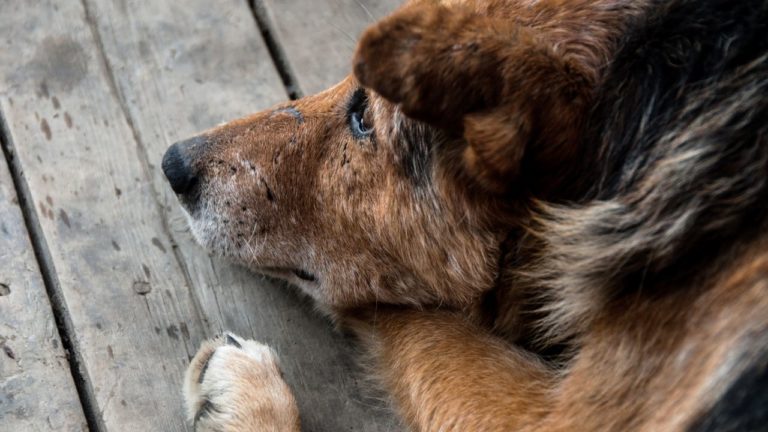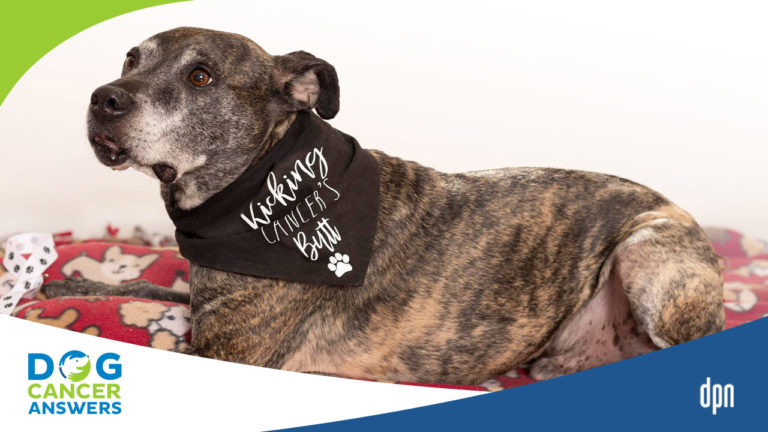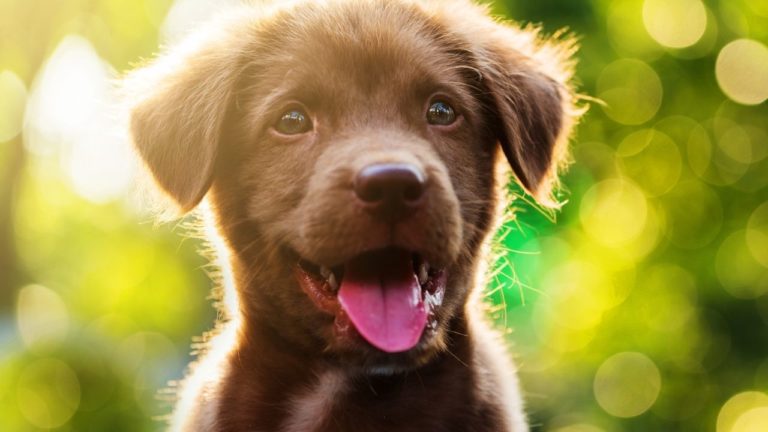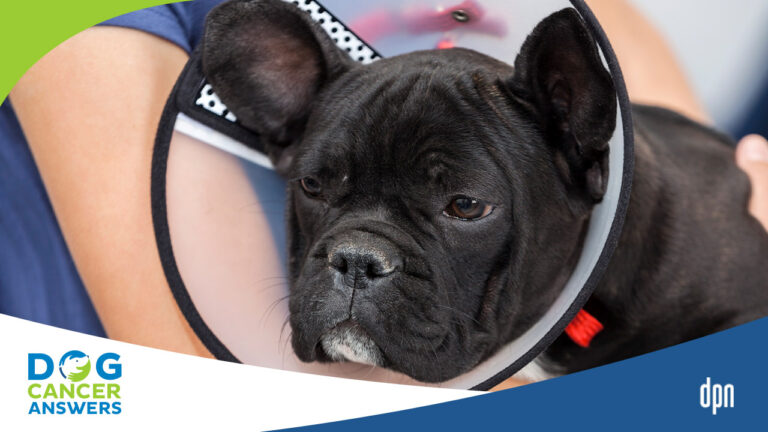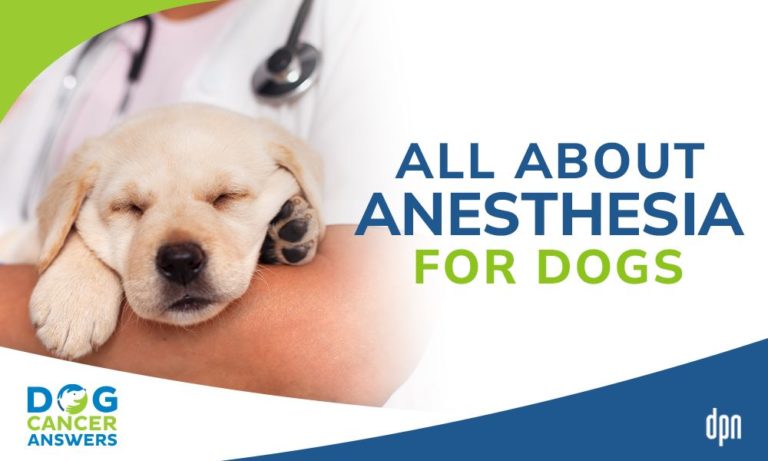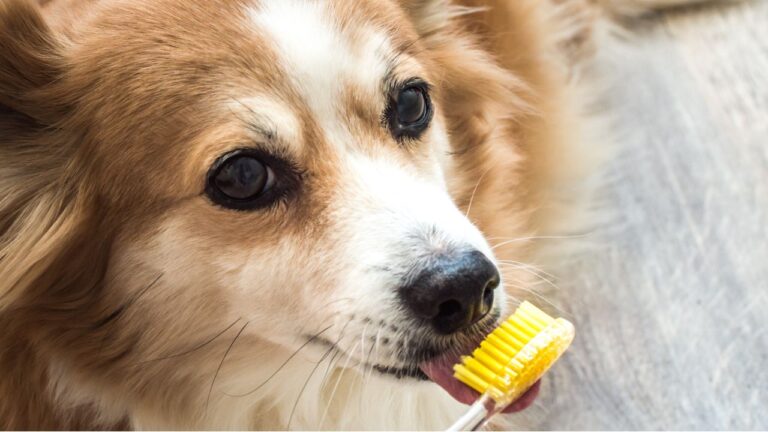Kanga’s True Tail
Every cancer journey is epic for the family. What happens when you "know everything" about dog cancer ... and your dog gets it?
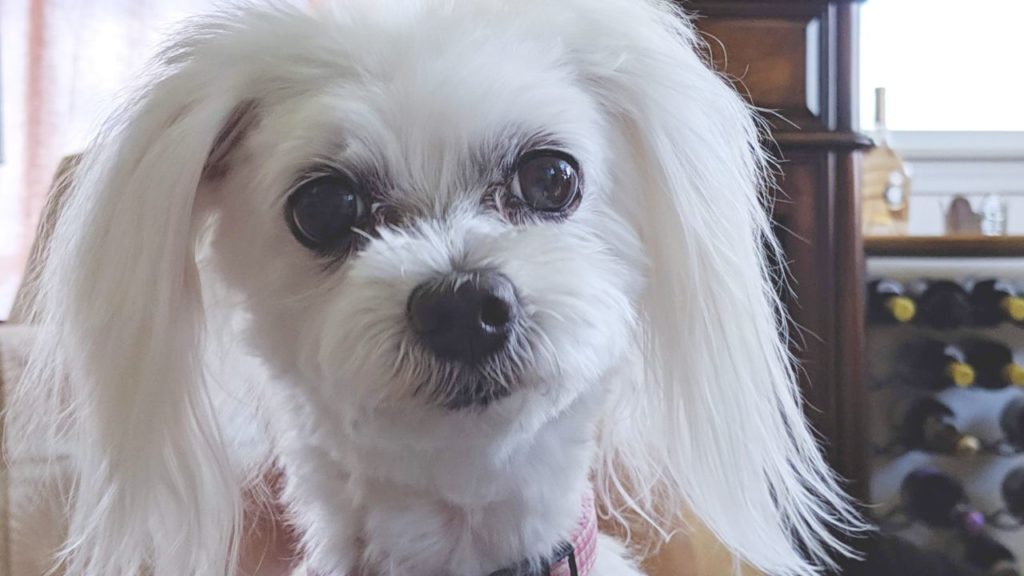
Read Time: 22 minutes
As the editor of The Dog Cancer Survival Guide, I’ve been thinking and writing about dog cancer every day since 2007. I have been helping run our social media groups, and answering hundreds of thousands of emails from dog lovers all over the world. This is not fun work, I’ll admit. But it feels important and meaningful.
And now it’s directly relevant to me … because it’s time for me to write my own Kanga’s True Tail.
I’m writing this in December of 2018, just after my little Kanga faced her own dog cancer surgery. I hope to impart a few of the things I learned over the last few months below. There are also a few videos to share with you … don’t worry — nothing too graphic.
(I’m still quite raw emotionally, so I may not be very articulate and organized. I apologize in advance for that, and hope that if you have questions or need clarity, you will let me know so I can address your feedback.)
Editor’s Note: This article was originally written for a retired blog about cancer in December 2018. My most recent updates for Kanga’s health are below the main article.
You Can Do Everything “Right” and Still Get Cancer 🙁
Here’s the shocking truth about my dog’s cancer: I’ve done just about everything right as a dog mom. When Kanga, an eight-pound Maltese, came to live with us at age 13 weeks, I took Dr. Dressler’s advice:
- Delayed spay (actually, never did one for various reasons)
- Never, ever fed her commercial kibble, instead using The Honest Kitchen as a minimal base for a homecooked diet of 50% lean proteins and 50% cruciferous veggies.
- I gave her Dr. Dressler’s daily supplement formula, EverPup, every day starting at age two when it first arrived on the market.
- She’s had daily walks, most days on the beach.
- We give dozens of pets and snuggles a day.
True to the Maltese breed, her teeth are awful — but otherwise, she’s been almost disgustingly healthy. She just turned ten in October but routinely gets mistaken for a puppy.
So what happened?
Finding the Lump
I took Kanga to see Dr. Dressler in late September for a physical. She had two small lumps near her mammary glands and needed a tooth cleaning.
I knew her teeth had been bothering her for a while. She’d become picky about food and sometimes didn’t want to eat at all. Her breath smelled like a garbage truck. I avoided bringing her in because I am always worried about anesthesia risks. (I myself do horribly on anesthesia and get sick and have a hard time waking up. This is probably something I have to stop projecting onto my dogs, because anesthesia is generally safe!)
Finally, when Kanga vomited three mornings in a row, I decided we better go in.
Pro Tip: If your dog is vomiting thin yellow bile in the morning and has stinky breath, it could be an abscess draining to the stomach and irritating the whole system. It could also be something worse. Don’t be like me; take your dog in for regular oral hygiene appointments.
Dr. D examined her thoroughly, including x-rays to ensure her lungs were clear for anesthesia. (At ten, she’s getting to that age when it could be riskier.) The plan was to schedule surgery to biopsy those little bumps and do a teeth cleaning at the same time.
He put her on a round of antibiotics to clear her obvious mouth infection, gently advised me that she would likely lose a dozen teeth, and sent me home.
My husband Jim was traveling, and I decided to wait until he returned before bringing her back for a follow-up. I can’t tell you why, exactly, but it had something to do with me being a wimp and not wanting to deal with the stress of worrying about her all by myself.
My Delay May Have Saved Her Life
It took about five weeks for us to get back to Dr. D’s office to get her pre-dental bloodwork done, which was a blessing.
Why? Because when Dr. D examined her again, he paused as he palpated her abdomen.
“There is a lump here that was not here a month ago.”
Oh. My. Word.
If we’d gone in a few weeks earlier, we might have never found that new tumor. We’d have just cleaned her teeth, gotten the likely slow-growing mammary masses biopsied, and then waited months to “torture” her with another vet visit!
Sometimes, procrastination pays off. (Sometimes.)
But Does She Really Need Dog Cancer Surgery?
Ultrasound was ordered, and there it was — a mass 2.5cm long where her right ovary should be.
What had been a discussion about routine dental cleaning was turning quickly into a discussion about biopsies, prognosis, and ovarian tumor types.
Good grief. I had been mildly worried about the mammary masses. But they were tiny, and that’s not typically super-aggressive cancer in dogs. But this? Who knew what we were dealing with?
I remained calm, especially compared to how most people feel when getting this news.
Things I Can’t Control
I know so much about how common dog cancer is — how stupidly, ridiculously often people lose their dogs to cancer — that I can’t say I was surprised, exactly. There are many cancer causes, and many things have to go wrong for it to arise. And most of those things are not in my control.
After all, we live about five miles away from a field where a giant biotech company sprays cocktails of herbicides and pesticides on their seed corn to see if it can withstand the chemicals. We’re downwind, and I am acutely aware that open-air spraying of those substances really increases our exposure.
Closing windows and eating organic food can help, but I can’t avoid exposure from walking outside, breathing our air, or swimming in the ocean off that field.
Reality Check
One out of two dogs over the age of ten gets cancer. One out of seven dogs eventually gets cancer. It’s the number one cause of death in dogs, after shelter euthanasia. I’ve known this for years.
I’ve been emotionally preparing for the reality that I could do “everything right” at home … and my Kanga and Roo could still get cancer.
Even with all this knowledge, I was gripped by apprehension and doubt. Could I really let Dr. D cut her open? Was the risk really worth it?
Was the risk really worth it?
The look in his eyes told me what I needed to know: yes, it was worth it.
“This thing has been growing quickly. We’ve got to get it out and see what else is going on.”
We scheduled the surgery for a few days later, early on a morning when he had no other surgeries and could monitor her all day after.
Hand Feeding Her “Last Meal”
Between the mouth infection and cancer (two kinds, likely!) Kanga had become super picky about food, and we had to hand-feed her by this point.
The night before surgery my husband James decided she needed a special meal. We are kinda superstitious, so I won’t call it her “last meal.” But for the first time ever she got to sit up with us at the table.
We had to put a bunch of pillows on the chair and her dog bed on top of that. I felt ridiculous, because I’m not really a dog-at-the-table kind of dog mom. But … we really wanted her to eat, because we knew she hadn’t been and wouldn’t for a few days. So, anything to get her interested!
Here’s a home-movie video I took of James hand-feeding her a turkey or beef burgers and rice dinner.
I’m laughing at myself right now because even watching that video a month later, I think, “ugh, her freshly washed hair is getting in the plate!”
Pro Tip: if you can bathe your dog before surgery, do so. It will be a while before they can get anything other than a sponge bath while the wounds heal!
Day of the Dog Cancer Surgery
I’m not going into details about the surgery itself because the images I saw on Dr. D’s phone are just not ones I want to think about (let alone show you). Here are the basic facts.
- It took nearly 3 hours, which is a long time for a ten-year-old, eight-pound dog.
- The right ovary had tentacles that “reached out” and attached to the kidney, its neighbor, and the spleen, which is not a neighbor.
- There were multiple blood vessels Dr. D had to cut to get the whole thing out. One image I don’t want to remember showed multiple little ligations bristling out — I imagine it was dozens, but I didn’t ask him to count.
- The tumor was bleeding inside — a slow, oozy type of bleed that can happen when a tumor grows so fast that it outgrows its own blood supply and starts to die off. If left inside her, that bloody tumor could very likely have erupted into a life-threatening internal bleed.
- The other ovary was “degenerating,” and the uterus was full of what later turned out to be endometriosis.
- Kanga did much better under anesthesia than any of us thought she would.
- Dr. D was also able to get her teeth cleaned and extract the abscessed tooth.
- He was pretty sure he’d gotten all of the ovarian tumor out.
- He didn’t feel like he could keep her under to remove the two little mammary tumors. It didn’t feel like a priority, and we had decided ahead of time that they were lower priorities than the ovarian tumor and her teeth.
I was really, really grateful that Dr. D was there for us and for Kanga. Before the surgery, when I handed her over to him, he said “I’m going to take good care of her,” and I knew he was making a soul-deep commitment.
I didn’t quite hold my breath until the phone rang to tell us she was out, but I did get a little lightheaded a few times.
When we picked her up later that day, Kanga was mad at me for the first time. She wouldn’t look at me. She didn’t kiss me for nearly 48 hours. That had never happened before. Ever since we’d first met when she was thirteen weeks old, she’d smiled at me, unfailingly, every time she saw me.
Not that day. She felt, and looked, awful.
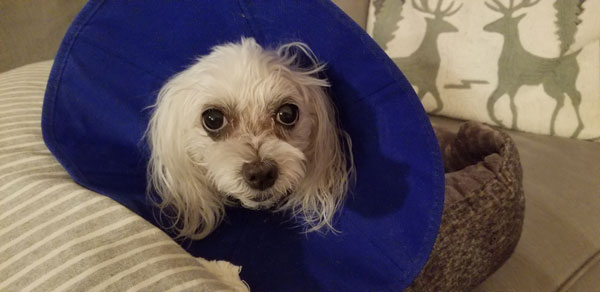
I felt like a big, mean, awful jerk when Kanga stared at me like this.
Night of the Dog Cancer Surgery
That night I held her in my arms in bed at an angle that prevented her from putting pressure on the massive, six-inch-long belly scar she sported. The staples were so close together (thanks, Dr. D, for your fantastic work that didn’t even leave a scar!) that they looked like a zipper up her abdomen, and she moaned or squealed throughout the night.
I was a massage therapist, and I know my hands “feel good” to others. But that night, I didn’t feel I could offer her comfort. The best I could do was simply give Reiki all night long.
It was horrible. As I lay there, listening to her whine-breathe, I truly regretted the surgery.
I kept thinking, “it couldn’t possibly be worth all this pain, all this trauma.”
Natural, Normal, Second-Guessing Denial
After a few hours of sleepless self-denigration, I realized I was doing exactly what I’ve seen so many other dog lovers do — second-guessing myself.
I did what I advise others to do. I worked it all through in my mind. I followed my thoughts to their logical conclusions. Here’s just a sample of what I thought, and then answered.
- I shouldn’t have had the surgery. I should have just let her be.
- OK, well, then what would be a likely scenario?
- She would die of catastrophic internal bleeding … and I would feel terrible because I knew she had this massive tumor inside and didn’t take it out.
- The only way that would have been OK is if I hadn’t known about the tumor.
- But then I would have been mad at myself for not getting her teeth cleaned sooner!
I started to relax a little as I realized that no matter what, I would blame myself or try to blame others for what Kanga was going through. It’s a normal, natural part of denial.
I was just in denial about this whole thing because I couldn’t bear her pain.
Cut yourself some slack. You will always second-guess yourself.
So, my job was to cut myself some slack and realize that I had made the best choice possible.
If Kanga recovered fully, the surgery would have removed a massive tumor that could have killed her in weeks.
My job now was to care for her post-surgery and wait for the biopsy results. Both would take at least 12 days — so I just had to focus on her care.
It didn’t help me sleep, but I wasn’t beating myself up all night.
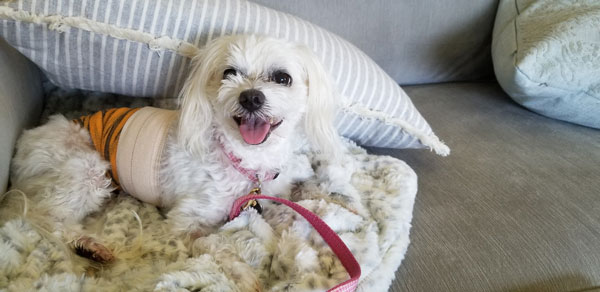
Post-Dog Cancer Surgery Care
This is where the book really came in handy for me. While most readers will find an entire chapter about their dog’s tumor in The Dog Cancer Survival Guide, there isn’t one on rare ovarian tumors. So I focused on wound care and absolute, 100% rest for my pup.
She has always had panic attacks in her crate, so I got a dog sling for around the house and kept her on her leash at all times.
I tied her up on her little dog bed so she couldn’t move even when she wasn’t on my body. It was kind of cozy.
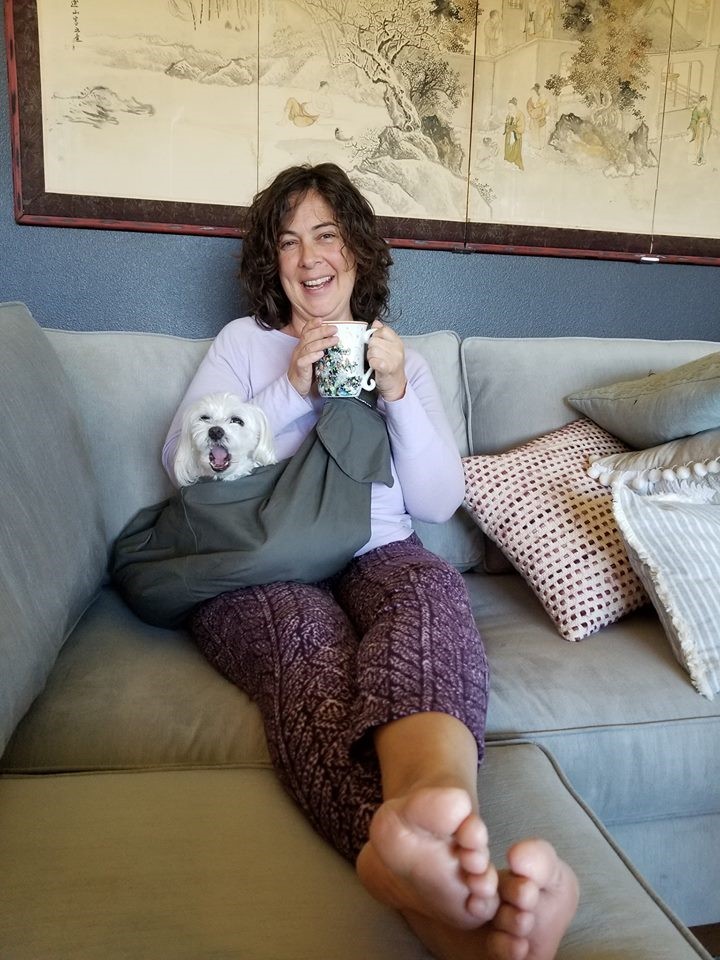
I kept her cone on, even though she HATED it.
I made sure she was as clean as possible but didn’t bathe her.
I was fussy about her antibiotics and pain medications, absolutely refusing to take NO for an answer on anything.
When we went outside so she could relieve herself, I didn’t let her go farther than her six-foot leash allowed.
My husband and I both pray and have Reiki, so we did a LOT of both.
Dogs don’t know they need almost total rest. Make sure your dog gets it after surgery!
Every day, thankfully, she improved. Kanga even started offering me her belly for rubs after five days.
She started eating as her mouth recovered from the extractions, and that really helped to perk her up.
By the time we went back on day 12, Dr. D was thrilled to be able to remove all the staples and give her the OK for walks around our neighborhood.
He was also thrilled to give us the BEST POSSIBLE OUTCOME: her tumor type.
Granulosa Cell Tumor!
Based on what he’d seen in surgery, we were all prepared to find out that Kanga’s tumor was an aggressive carcinoma that would likely have already spread despite her looking clear on both X-rays and ultrasound just weeks ago. In that case, we would prepare ourselves for an end-of-life situation within the next few months.
But that’s not what she had. She had a granulosa cell tumor, which, thankfully, has the best prognosis. While they can metastasize, the likelihood that it happens is only 20%!
As of now, we don’t see any spread on imaging, and he thinks he got the entire tumor out in his marathon surgery.
So, at this point, we are breathing a sigh of relief. For now.
And Kanga? She feels FANTASTIC. She’s playing, running, jumping, and acting like nothing happened.
Follow Up Treatments and Check-ups
In four months, we will head back to the vet (despite her literal screams of protest) to check and see if any more tumors appear on imaging. But in the meantime, Kanga will be on Dr. Dressler’s Full Spectrum Cancer Care recommendations, the same ones that millions of dog lovers have told me over the last decade have helped their dogs.
And yes, for the rest of her natural life — whatever that is — we will assume that she has cancer on a microscopic level. It’s just smarter that way.
UPDATE: Kanga remains cancer-free at the end of May 2021. She still has those tiny masses on her mammaries, but they haven’t gotten larger and aren’t attached to the abdomen, so we are not worrying about them now. Follow-up ultrasounds reveal no problems inside. Thankfully! I’m even considering having her teeth cleaned again. She might forgive me quicker if she wakes up without stitches.
Full Spectrum Cancer Care Recommendations I’m Following for Kanga
I’m a good student, so I’m taking this cancer thing as my teacher Dr. D recommends: one step at a time.
- Step One is Conventional Tools Like Surgery, Chemotherapy, or Radiation … in our case, surgery has been a success, and she is healing REALLY well. Not even three weeks after undergoing that massive surgery, she is back to her puppy-like ways, eating happily and taking walks, including, as of this morning, on the BEACH. My husband James and I have already decided that at her age, we will not likely do another surgery even if another tumor appears. She really hated the process, and unless it’s very discrete and easy to take care of, it’s probably not worth the life quality loss for her (and for us). These tumors spread to the lungs and abdomen, and we just can’t see opening her up again at her age. If we see spread in a few months, we will not do chemotherapy or radiation to treat it. The protocols are not worked out for these rare tumor types, and we don’t want to put her through it if we don’t have solid numbers telling us it’s worth it. We don’t have those, so we likely aren’t doing it.
- Step Two is Nutraceuticals … dietary apoptogens may really support normal cell turnover and encourage cells to “wake up” and eliminate themselves BEFORE they become problems. Nutraceuticals are discussed in chapter 12. We use Apocaps CX, because it’s appropriate for Kanga, has no side effects to worry about, and supports her life quality while we wait to see what else happens with this stinking thing.
- Step Three is Anti-Metastatic Supplements and Immune Boosters … I’ve got her on a medicinal mushroom blend to boost her immune system called K9 Immunity (other brands work, too), plus a Transfer Factor that boosts its effects. I’ve also put her on modified citrus pectin, another dietary apoptogen that also offers good anti-metastatic support. She’s sleeping in total darkness, getting plenty of sunlight, and taking EverPup as her multivitamin.
- Step Four is Diet … I’ve given Kanga fresh food since her puppyhood, but now I’m a lot stricter about low-carb foods and making sure she gets plenty of liver and cruciferous veggies. This step I’ve already been doing, but I’m becoming more conscientious, for sure.
- Step Five is Brain Chemistry Modifications … including daily exercise, massage, as much Reiki as she likes (and she likes a lot), and plenty of fresh air. I’m also starting to meditate with her again. I’m sorry I ever stopped!
What I Learned:
Here’s a partial list of what I learned during the last few months that I either didn’t fully understand before or plain didn’t know:
- My dog’s occasional hesitancy to eat, which started about four months ago, should have been a major red flag that SOMETHING was wrong.
- Tumors can die and start to bleed even as they grow — and if the dying tumor cells are in or near a major blood vessel, this can open up a hole that dumps blood into the dog’s body cavity. While Kanga’s tumor was “oozing” not “flowing” with blood, it could have been much, much worse. These bleeds are life-threatening.
- Because of the above, I now really understand why vets always “want to cut it out.” It’s not just about (or even really about in some cases) removing cancer. It’s about saving the dog from a disgusting, painful death from a potentially catastrophic internal bleed.
- I could beat myself up for “waiting too long” to get it addressed, but then again, waiting, we were able to find a life-threatening situation that was not noticeable during a regular exam.
- Imaging is expensive, but man, it sure clarifies things. Seeing a clear x-ray of her lungs was such a relief. Seeing the ultrasound of the ovarian tumor was motivating.
- I will stop judging myself for everything when my dog is in pain or sick. I have to really cut myself some slack to stay focused and make good decisions.
- When the discharge instructions say “complete rest,” they MEAN it. The incision wasn’t the only thing Kanga had to heal. She also had to heal all of the INSIDE wounds from the surgery.
- My dog really, really wants to lick her paws. She’s like a little kid who chews her nails.
- Dogs really do live in the moment. Once her pain and swelling went down, she just bounced back energy-wise. If I’d had a major abdominal surgery, I would not want to go for a walk just a few days later. I’d still be in bed three weeks later!
- I had to adjust my expectations of myself to accommodate the intensive care needs of my dog. I work from home, so I’m lucky I was able to be there all the time, but I had to let go of lots of other things, like my own workouts and sparkling clean toilets. I have a new appreciation for how upsetting it must be for someone who must leave their dog all day while they heal. If you can arrange to work from home while this is going on for your dog, I would. But I realize that most can’t. This hurts my heart.
- I’m really lucky that I trust Dr. Dressler because handing her over to go under the knife was really, really scary.
- No matter how useful I’ve always known the book to be, I know now that it REALLY helps. I used the index multiple times a day to find something I needed to understand or remember.
Bottom Line
In all, I’m feeling much better. Kanga feels much better, too, which helps.
Thanks for reading this. I don’t think I realized how much better I would feel after writing all of this down! I hope it’s been helpful for you, too.
Before I go, though, I have three videos that you might want to see.
Videos of Dog Cancer Surgery with Dr. Dressler
Several years ago, Dr. Dressler had a cancer scare with his wonderful dog, Bjorn. He made videos of their progress, including before, during the surgery, and after, when he finally got the biopsy results. These have been on this site for years, but I think they’re worth reviewing now, especially if you are facing dog cancer surgery for your own pup. It might help to see that even veterinarians feel overwhelmed, upset, and impatient about how long it takes to find out the biopsy results!
Don’t worry — the video of the biopsy surgery is not TOO graphic!
Even Dr. Dressler feels terrible waiting for the results!
Update: November 18, 2019
It’s been almost a year since Kanga’s surgery, and I have to say, she’s doing great. Her scans have all been clean and clear, and she’s eating and walking and relieving herself and playing just like ever. Even though she is eleven years old, she still gets mistaken for a puppy.
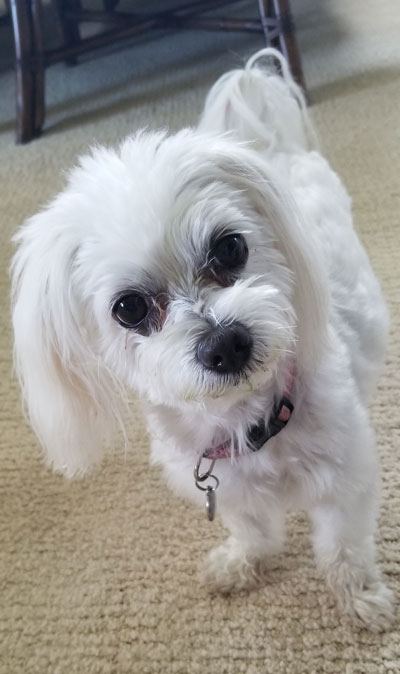
I could not be more grateful for her health. Not. More. Grateful.
Still, James and I are focusing on QUALITY OF LIFE over all else because we feel like we escaped a terrible fate quite narrowly.
We still think of Kanga as having cancer because we know that even with the tumor type she has, there is a chance that it metastasized.
Here is what we have been doing for the last year now:
- The dog cancer diet, as outlined by Dr. Dressler
- Healthy treats like berries, liver, and other yummies
- Apocaps CX, full dose for a 10-pound dog, daily to remind her apoptosis genes to monitor for deranged, damaged, or old cells.
- Medicinal Mushrooms (whatever we can find, usually K9 Immunity) daily to boost the immune system.
- Sardines a few times a week for the omega 3’s
- Modified Citrus Pectin as an anti-metastatic
- EverPup with every meal to make sure she gets a multi-vitamin and digestive/joint support
- Daily walks to boost life quality
- Lots of pets and snuggles and Reiki
- Meditation sessions. I swear, she LOVES meditating twice a day! I have to set up a sort of duplex situation on my lap to make it work for both Kanga and Roo. Kanga’s on the pillow, here. But you can see both of them are in full-on “hound lounge.”
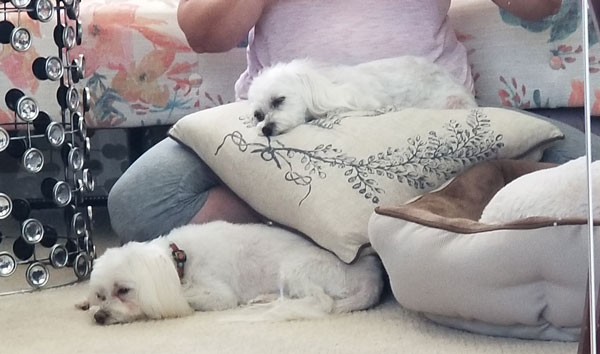
I know some people who have dog cancer would look at this list and think, “you’re not doing everything; you’re not doing enough.” I know that because I see the long lists of supplements some folks give their dogs … sometimes twenty or thirty at a time.
But I don’t want to duplicate supplements or throw her body off. I want to give her the support she needs and no more. There is such a thing as too much of a good thing.
This list has been enough, not too much, and not too little.
It addresses every single step in Full Spectrum Cancer Care. And I feel more strongly than ever that Dr. D has it right: some things can help most dogs, and we should use them. And then trust that it’s enough.
Whatever comes, I’m ready. At least, I think I am.
Future Worries
I still struggle to keep myself from worrying too much. Even now, when I told my husband James that I would update this article, he said, “Aren’t you worrying we are jinxing it? It’s not yet a full year.”
But I am doing it anyway because I find that the best way for me to deal with my anxiety is just to FEEL it.
Once I felt how anxious I was that November 29, 2019, is next week, I knew I should update this article NOW. It’s not a magical date.
As Dr. D says, no calendar has a date circled to tell me when Kanga will pass.
Superstitious thinking is normal, and I’m not going to beat myself up about it … but I also am not going to let it ruin another Thanksgiving!
Update: November 18, 2020
I was so superstitious about updating this article again, but here it is, a year later, and little Kanga is sassy and spunky as always. Here she is just a couple days ago, demanding to be taken out for a walk.
I could not be happier to report that Kanga still thrives. Does she still have those tiny masses on her lower belly? Yes, but they’ve gotten smaller! And while the rest of us wish the pandemic were history, she’s reveling in the extra attention she gets now that we are home 100% of the time!
As another Thanksgiving arrives, I am grateful for her and her love and health.
Happy Thanksgiving to those in the U.S., and warm wishes to the rest of the globe.
Update: December 9, 2021
Kanga is still doing great, and we continue all the same supplements and diet that we’ve been doing:
- a low-carb, high fat, moderate protein diet as outlined by Dr. D. in his book
- Apocaps at full dose
- Modified Citrus Pectin as outlined in the book
- Medicinal Mushroom as outlined
- Transfer Factor as outlined
- EverPup as a daily supplement/multivitamin, which is important when feeding a home-cooked diet
Last week, Kanga had to go in for an urgent care visit. She’s thirteen now, and it was just Thanksgiving, so I suspected pancreatitis. I didn’t give her A LOT of turkey, but I did give her some and didn’t wash off the gravy clinging to it. So I suspected her fatigue and not wanting to eat — and then a slight fever — was due to holiday indulgence.
Fortunately, it wasn’t pancreatitis. Unfortunately, it was SOMETHING in the belly.
X-ray and ultrasounds showed a mass. An aspirate was done. We just got the pathology report back, and it seems to be some sort of sarcoma.
It could be a metastasis from the ovarian tumor (remember that 80% chance of no metastasis? Maybe it’s caught up with her). It could be those mammary masses spreading — but those remain tiny and not rooted.
Or it could be a new cancer.
In a way, this is good news, because I was worried it was lymphoma and we wouldn’t have much time left with her. At thirteen and living in a very rural area, the likelihood of us choosing chemo for her is very low.
That may still be the case, but perhaps there is something we can do. We are visiting with Dr. Dressler this afternoon to go over the results from the urgent care session and see what he thinks.
In the end, at thirteen, she has reached a normal lifespan for her age and breed. The likelihood that she will live a LOT longer if we do another surgery is low.
The surgery Dr. D did three years ago resulted in a normal, healthy, fun life for her … for three more years. That means that she got 30% more life from that surgery. That was well worth it!
But she’s older now and less sturdy on her feet in general. She’s still sassy, but we’re not sure how happy she would be at another surgery and recovery.
I’ll update when we make some decisions.
In the meantime, we are continuing with what we’ve been doing for the last three years:
- a low-carb, high fat, moderate protein diet as outlined by Dr. D. in his book
- Apocaps at full dose
- Modified Citrus Pectin as outlined in the book
- Medicinal Mushroom as outlined
- Transfer Factor as outlined
- EverPup as a daily supplement (including a multivitamin, important when feeding a home-cooked diet)
After getting fluids last week, she’s been totally normal since leaving the hospital. She’s taking her walks, playing with toys, eating three square meals a day, taking her supplements … so as long as her life quality is high, we Type B folks will be thrilled.
Update: August 16, 2022
I’m very sad to give you this update, friend … but Kanga left us to cross the Rainbow Bridge and play with Roo on July 26, 2022, twelve days before the first anniversary of Roo’s death, and three years, seven months, and 27 days since her epic surgery.
And most of that time was just amazing in terms of life quality!
After her health scare last December, we tried a couple more aggressive anti-cancer tactics with Dr. Dressler’s guidance.
We added Low-Dose Naltrexone (LDN), and also hemp-based CBD in a higher dose than we had previously used on occasion for occasional comfort care.
But Kanga started to have diarrhea after a few weeks. Diarrhea is a big no-no for life quality in her estimation, so we stopped those two new additions to see if it cleared up.
Once off the LDN and CBD, she went back to what we call happy poops … and when we tried a lower dose of one and then the other, she had diarrhea again.
So we decided to stop those and continue with her other supplements that we knew she did well on.
February, March, April, May, and June all passed with beautiful experiences.
We went to the beach, we took our daily walks, we snuggled and enjoyed.
Every night at 8 pm, she insisted on playing for about 30 minutes, just like she has her whole life.
And on the evening of my 50th birthday, she brought me to the beach, and I saw a baby whale being born. Here’s an (edited for length) video Jim took of the amazing birthday gift she gave me.
The Beginning of the End … But Not Yet the End!
In mid-May 2022, Kanga started to slow down. She wasn’t as willing to take walks and stopped playing at night. She didn’t stop eating, but she got super picky.
After a few days, we knew we needed more support for her.
Either the metastasis was spreading, or her orthopedic pain (from a trick knee and back issues) was increasing.
Prednisone — a powerful steroid that can really quell inflammation and pain — was prescribed.
She felt better within a day! She was walking again, and she ate without complaint. Like many dogs do on pred, she started panting a little occasionally. She was hungry all the time and thirsty, too.
But the side effects were tolerable, and she smiled and wagged her tail again. She started taking walks and playing again.
Prednisone can be an excellent drug for life quality, although it can also shorten the time you have left.
But our mantra for Kanga was Life Quality First.
This dog was super dignified, friend. She had no interest in a bad day, thank you very much!
So we administered the pred and took her off other supplements that might have increased the risk of tummy upset. After about a week she was just on the pred and EverPup.
She did very well until two months later when she started to slow down again.
And this time, it felt like she wouldn’t speed up again.
We added some gabapentin to see if it was orthopedic pain that just needed more support.
But that didn’t help.
Early in the morning on July 26, we woke up to snoring. Was it Jim or me?
Neither. It was Kanga, and it wasn’t snoring. It was her laboring to breathe as she slept.
She continued to labor that morning.
As I interviewed job applicants who wanted to help us with a new dog cancer project, she lay on my lap.
I could feel her ribcage harden more with each breath.
All of her accessory muscles were straining.
By 3 pm, we realized it had been 12 hours.
And we knew we were at the end.
She had started down the slippery slope. We had hours, not days, days, not weeks.
She would not come back from this, and she was clearly in pain.
We know what it’s like to be unable to breathe, and we didn’t want her to experience that for longer than necessary.
It was late, but we called veterinarians all over to see if anyone could help us help her pass.
We were able to get one appointment to help her. It was in a beautiful place, with a caring and compassionate young veterinarian.

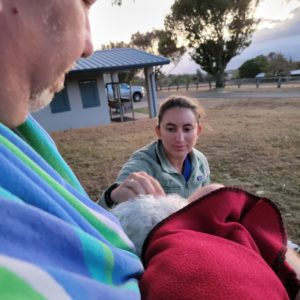
When Kanga took her last breath, we were sitting under that huge avocado tree, watching the last rays of the sun shine through the dark. It was quiet, peaceful, and dignified.
Seconds after Jim and I felt Kanga go entirely still, sirens started wailing. A string of lights blazed along the road below as emergency vehicles passed on their way to their calling. All three of us humans took a big breath together as the sounds and lights filled up our experience.
It felt like the world was proclaiming Kanga’s greatness as she melted into the dark. We all felt something sacred and awesome.
It was a Good Death. But the Pain Is Real
Her death has inexorably changed my life.
I consider myself an expert griever. I’ve had to do it many times, for many types of losses. I’m one of those ‘highly sensitive’ people who feel things very deeply, and so I’ve had to learn how to process and incorporate loss to just live a normal life.
Most of the losses I’ve mourned were complex and gnarled. This one was utterly simple.
It was like a French swordsman had been called to take my head off: cleanly, quietly, swiftly when I was looking the other way.
I’ve spent the last three weeks looking for my head and trying to stitch everything back together.
I don’t want to belabor the aftermath for you because I know you are dreading that day with your dog, and honestly, there is a book I want to write about grieving a dog.
So I’ll send you these posts I made for my loved ones. You can click to read more on Facebook, these are public posts.
Here’s the one I wrote immediately after we returned home on July 26:
Things were better a week later, when I had my first real visit from Kanga in a dream. Here’s that post:
Dear reader, thank you for reading.
Much Aloha and warm wishes to you and your dog. We’re all in this together!
Love,
Molly Jacobson, Editor
The Dog Cancer Survival Guide
Editorial Note: This post was originally published on a retired blog about dog cancer.
Molly Jacobson
Topics
Did You Find This Helpful? Share It with Your Pack!
Use the buttons to share what you learned on social media, download a PDF, print this out, or email it to your veterinarian.


